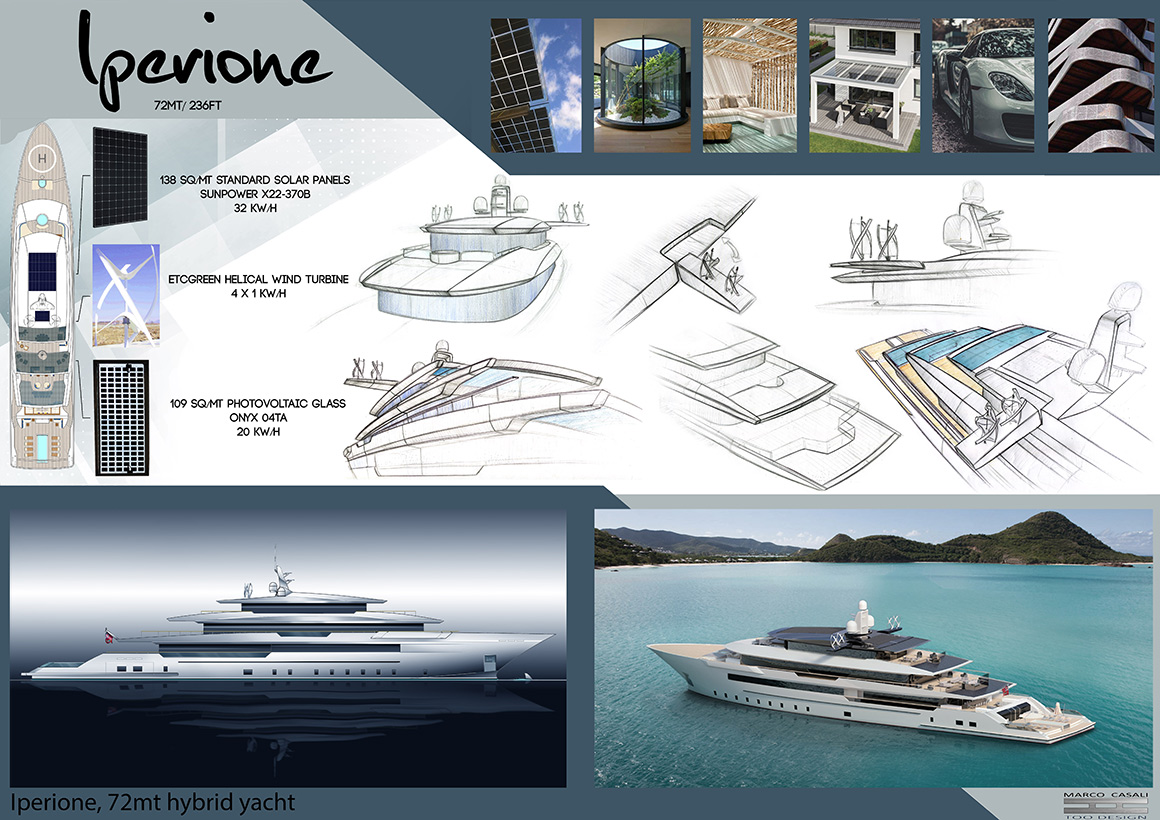It all began with a sketch – Yacht Design by Marco Casali
Who designed BAVARIA’s first ever flybridge yacht? Well, with the Virtess 420 Fly it was Marco Casali wo wrote a new chapter in the book of successful BAVARIA Yachts. And now the dynamic architect is sharpening his pencil for the S- and the SR-line.

Marco Casali doesn’t need a long warm‐up. Mere seconds pass between the first „Buongiorno“ and an animated conversation. „We’re all men of the sea“, he says. Casali had been out to sea with his family when still a little boy, and in the harbor he loved „Yacht Watching“ even as he held his father’s hand. At home, he drew his vision of a dream boat, and from six to. 10 years of age he filled an entire portfolio with drawings of sleek motorboats. Fortunately, his mother kept these early works, otherwise this account could too easily have been dismissed as a marketing ruse.
Later he was attracted to the water, first as a surfer, and then sailing a Tornado catamaran. When chartering boats with friends for holidays, he early on preferred BAVARIA sailing yachts: „They were simply more reliable than other boats! So, we could enjoy our holidays in Greece and Croatia without a concern“.

From studying architecture to self‐employment in yacht design
At first Casali studied architecture, but his passion for the sea caught up with him again. In a competition, where a nautical magazine asked its readers to draw their dream boat, he won the 1st prize. This resulted in years of collaboration with the best yacht design studios in Italy, until he finally became self‐employed in 2004.
Even though he had already developed successful yacht projects for well‐known bands, the call fom Giebelstadt came as a surprise. „At first, I thought it might be a joke. Bavaria was also working with BMW Design at that time.“ Casali knows what owners want, having experienced the very same emotions at first‐hand. To have everything within a small space, plus a pinch of comfort, all at close proximity to the water and with the sporty potential for a swift sail from A to B.

A new design for the S‐Line
With the BAVARIA S‐Line, Casali was challenged on other levels, and it wasn’t a case of revolution so much as evolution. He would go on to fully exploit the potential of the model series and develop it further over the longer term. Casali starts with the boat’s volume, enlarging it to provide more space.
„In the past, the cockpit was only there for sailing the boat, but today we integrate it into the experience zones“, Casali explains one of his tricks. „On a given length of boat, the space is always the same. It all depends on how you restructure it.“ On a boat, you want to be outdoors whenever possible, whereby the dinette itself can also get more of an open‐air feeling. Living spaces in the boat should have more than one use, where, for example, seating is readily transformed into areas for lying down in. The S‐Line wet bar is now the largest in it’s class, while bigger windows provide light even below deck and overall, the comfort factor has been significantly increased.

Boat and furniture construction hand in hand
During his visits to Giebelstadt, Marco Casali and his team also made direct contact with the shipyard’s boat and furniture builders. Despite series production, there is still a lot of manual work to be done on a BAVARIA yacht, and the designers wanted to analyse the two different working environments more closely to factor them into their work. Innovations should not only look good on paper, but also fit perfectly into the production workflow.
For around 10 years Casali has also been designing super yachts of up to 110 metres in length. While you can indulge every extravagance in such vessels, smaller boats demand greater economy of space. It’s particularly impressive then, that while Casali and his Too Design team get the maximum out of smaller projects, they never look unwieldly. The „Italian Job“ naturally also features a special elegance with sporty look, and dynamic lines.


Design with the drawing pencil
And how does he find inspiration? „This happens best when travelling. When I’m on the move on a train, or on an airplane, and cut off from the studio, the ideas just flow into my paper notebook. I began my studies using drawing ink and finish them on the computer. But no computer, however fast, can translate my ideas as directly as a pencil.”
Environmentally compatible design
Casali, who privately direces a Tesla, also feels increasingly committed to the environment in realizing his work. In addition to the classic powerboats, his reference list also includes exciting new concepts. The solar catamaran Silent 79 is just one example of the future orientation of yacht concepts. Super yachts will also increasingly show their green side in the future as drive and battery technologies make further progress.

Marco Casali Too‐Design is a studio dedicated to the architecture and yacht design located in Rome. Since his childhood, the founder has harboured a special passion for ships and the sea. Having graduated in architecture, Casali began to work at an interior design studio. His interest in the boating business, however, drew him even closer to the sea, and he began a six‐year period working with large studios that realized projects for clients like Feretti, CRN and Bertram. In 2004 he founded his own studio, since when he has realised over 300 projects for companies such as Itama, BAVARIA, Nix Catamarans and ZL RIBs. Since 2010, Casali has also worked on developing large yachts of between 30 and 110 metres for such yards as Benetti, ISA Yachts and Fincantieri.